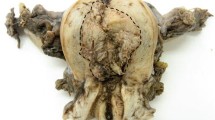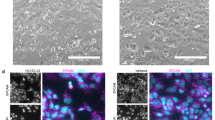Summary
Two in vitro passages of a human endometrial adenocarcinoma continuous cell line (RL95-2), an early (subcultured <30 times) and a late passage (subcultured >200 times) have provided an interesting model to study the growth, morphologic, and invasive properties of endometrial tumors. The early passage, which has been shown to be estrogen-receptor positive, has characteristics closely resembling a primary tumor, whereas the estrogen receptor negative late passage exhibits several features of the metastatic phenotype. Compared to the early passage cells, the late passage cells were less serum dependent, formed foci, demonstrated a faster rate of growth (due to their shorter doubling times), and attained higher saturation densities. The late passage cells also displayed an altered morphology which was accompanied by alterations in the distribution of F-actin. Even though early and late passages showed similar invasive potential in an in vitro invasion assay, the late passage cells, by virtue of their several transformed characteristics, maintain distinctive properties compared with their early passage counterparts.
Similar content being viewed by others
References
American Cancer Society. Cancer facts and figures. Atlanta, GA: American Cancer Society; 1989.
Ben-Ze’ev, A. The cytoskeleton in cancer cells. Biochim. Biophys. Acta. 780:197–212; 1985.
Chen, L.; Lindner, H. R.; Lancet, M. Mitogenic action of oestradiol-17β on human myometrial and endometrial cells in long-term culture. J. Endocrinol. 59:87–97; 1973.
Damjanov, I. Ultrastructural pathology of human tumors, vols 1 and 2. Philadelphia: Eden Press; 1980.
Fidler, I. J. Tumor heterogeneity and the biology of cancer invasion and metastasis. Cancer Res. 38:2651–2660; 1978.
Folkman, J. Tumor angiogenesis. Adv. Cancer Res. 43:175–203; 1985.
Friedman, E.; Verderame, M.; Winawer, S., et al. Actin cytoskeletal organization loss in the benign to malignant tumor transition in cultured human colonic epithelial cells. Cancer Res. 44:3040–3050; 1984.
Gehlsen, K. R.; Wagner, H. N.; Hendrix, M. J. C. Membrane invasion culture system (MICS). Med. Instrum. 18:268–271; 1984.
Ghadially, F. N. Ultrastructural pathology of the cell and matrix, 3rd ed., vols 1 and 2. Boston: Butterworths; 1988.
Ghadially, F. N. Diagnostic electron microscopy of tumors, 2nd ed. Boston: Butterworths; 1985.
Gorodecki, J.; Mortel, R.; Ladda, R. L., et al. Establishment and characterization of a new endometrial cancer cell line (SCRC-1). Am. J. Obstet. Gynecol. 135:671–679; 1979.
Grenman, S. E.; Van Dyke, D. L.; Worsham, M. J., et al. UM-EC-1, a new hypodiploid human cell line derived from a poorly differentiated endometrial cancer. Cancer Res. 48:1864–1873; 1988.
Gusberg, S. B. Current concepts in the control of carcinoma of the endometrium. Cancer J. Clin. 36:245–253; 1986.
Hendrix, M. J. C.; Seftor, E. A.; Seftor, R. E. B., et al. A simple quantitative assay for studying the invasive potential of high and low human metastatic variants. Cancer Lett. 38:137–147; 1987.
Hendrix, M. J. C.; Seftor, E. A.; Seftor, R. E. B., et al. Comparison of tumor cell invasion assays: human amnion versus reconstituted basement membrane barriers. Invasion & Metastasis 9:278–297; 1989.
Heppner, G. H. Tumor heterogeneity. Cancer Res. 44:2259–2265; 1984.
Ishiwata, I.; Nozawa, S.; Inoue, T., et al. Development and characterization of established cell lines from primary and metastatic regions of human endometrial adenocarcinoma. Cancer Res. 37:1777–1785; 1977.
Korc, M.; Padilla, J.; Grosso, D. Epidermal growth factor inhibits the proliferation of a human endometrial carcinoma cell line. J. Clin. Endocrinol. Metab. 62:874–880; 1986.
Korc, M.; Haussler, C. A.; Trookman, N. Divergent effects of epidermal growth factor and transforming growth factors on a human endometrial carcinoma cell line. Cancer Res. 47:4909–4914; 1987.
Kruitwagen, R. F. P. M.; Poels, L. G.; Willemsen, W. N. P., et al. ETN-1: A new human endometrial carcinoma cell line producing ascites and distant metastases in nude mice. Int. J. Cancer 43:1098–1103; 1989.
Kuramoto, H.; Tamura, S.; Notake, Y. Establishment of a cell line of human endometrial adenocarcinomain vitro. Am. J. Obstet. Gynecol. 114:1012–1019; 1972.
Kuramoto, H.; Hamono, M. Establishment and characterization of the cell-line of a human endometrial adenocanthoma. Eur. J. Cancer 13:253–259; 1977.
Liotta, L. A. Tumor invasion and metastasis—role of the extracellular matrix: Rhoads memorial award lecture. Cancer Res. 46:1–7; 1986.
Morgan, J. F.; Eng, C. P. The induction of immunoprotection by mouse ascites tumor cells attenuated in tissue culture. Proc. Soc. Exp. Biol. Med. 134:305–308; 1970.
Neri, A.; Nicolson, G. L. Phenotype drift of metastatic and cell-surface properties of mammary adenocarcinoma cell clones during growthin vitro. Int. J. Cancer 28:731–740; 1981.
Nicolson, G. L. Generation of phenotypic diversity and progression in metastatic cells. Cancer Metastasis Rev. 3:25–43; 1984.
Nishida, M.; Kasahara, K.; Kaneko, M., et al. Establishment of a new human endometrial adenocarcinoma cell line. Ishikawa cells, containing estrogen and progesterone receptors. Acta. Obstet. Gynaecol. Jpn. 38:1103–1111; 1985.
Pavlik, E. L.; Katzenellenbogen, B. S. Human endometrial cells in primary tissue culture. J. Clin. Endocrinol. Metab. 47:333–344; 1978.
Poste, G. Cellular heterogeneity in malignant neoplasms and the therapy of metastases. Ann. NY Acad. Sci. 391:34–48; 1983.
Satyaswaroop, P. G.; Bressler, R. S.; De La Pena, M. M., et al. Isolation and culture of human endometrial glands. J. Clin. Endocrinol. & Metab. 48:639–641; 1979.
Sundareshan, P.; Misiorowski, R. L.; Davis, J. R., et al. Effects of epidermal growth factor on response, morphology, and invasive potential of human endometrial carcinoma cell line RL95-2. Cancer Comm. 3:149–158; 1991.
Taketani, Y.; Mizuno, M. Characterization of epidermal growth factor (EGF) receptor in human endometrium and its cyclic changes during the menstrual cycle. Arch. Gynaecol. 237:A14.28-03; 1985.
Trent, J. M. Functional and morphological characterization of normal and carcinomatous endometriumin vitro. In: Webber, M. M., ed.In vitro models for cancer research, vol. III. Boca Raton, FL: CRC Press; 1986:153–187.
Varani, J.; Lovett, E. J. Phenotypic stability of murine tumor cellsin vitro andin vivo. JNCI 68:957–962; 1982.
Volk, T.; Gieger, B.; Raz, A. Motility and adhesive properties of high and low metastatic murine neoplastic cells. Cancer Res. 44:811–824; 1984.
Way, D. L.; Grosso, D. S.; Davis, J. R., et al. Characterization of a new human endometrial carcinoma (RL95-2) established in tissue culture. In Vitro 19:147–158; 1983.
Welch, D. R.; Tomasovic, S. P. Implications of tumor progression on clinical oncology. Clin. Ex. Metastasis. 3:151–188; 1985.
Author information
Authors and Affiliations
Rights and permissions
About this article
Cite this article
Sundareshan, P., Hendrix, M.J.C. Growth, morphologic, and invasive characteristics of early and late passages of a human endometrial carcinoma cell line (RL95-2). In Vitro Cell Dev Biol - Animal 28, 544–552 (1992). https://doi.org/10.1007/BF02634139
Received:
Accepted:
Issue Date:
DOI: https://doi.org/10.1007/BF02634139




